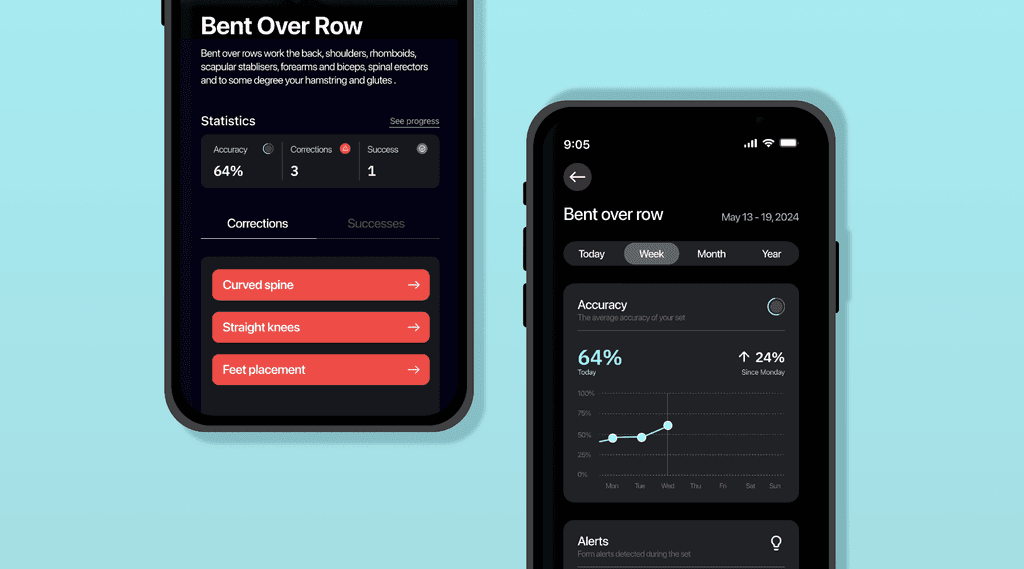Helping Lifters Train with Real-time Form Feedback to Prevent Injury
Spot Me
Project Overview
Weightlifters are most likely to seriously hurt themselves when lifting heavy weights if their form is incorrect. Since they usually lift alone and without a trainer, they don't have someone to rely on to help them lift safely. To help solve this problem, I designed Spot Me- a mobile app that "spots" users while they film themselves lifting and analyzes their form in real time to provide corrective feedback, improve their workouts, and prevent injury.
How Did I Add Value?
I led the end-to-end product design process, uncovering key pain points in weightlifting through 10+ user interviews. These insights shaped feature direction and validated user needs. I also built a full design system and brought the MVP to life with a high-fidelity prototype.
Skills
User Research
Design Systems
Prototyping
Timeline
Jan - May 2024
Tools
Figma
Adobe AfterEffects
The Problem
Incorrect form leads to serious injuries
People think weightlifting injuries are related to gender, age, or weight- but that's not the case. In a study conducted by the NHI, the only significant association found was between weightlifting injuries and the weight carried. That means as lifters increased the weight carried with incorrect form, their chances of injuring themselves increased too.
61%
Of weightlifting injuries are due to technical errors
CBI Insight, 2018
"I hurt my shoulders really badly because I kept lifting heavier weights. I was trying to train my chest, but I didn't know the right degree to do it."
Hao,
LIFTING FOR 10 YEARS
Research
Why are lifters struggling with form?
To get a holistic perspective on this issue, I researched tech trends in fitness and conducted interviews with 5+ weight lifters. They ranged from beginners with less than a year of experience to veterans who've been lifting for years, and from those who don't use any tech to avid trackers. I gathered over 150+ data points that revealed key challenges:
Hard to Follow Online Workouts
Only following apps or workout videos makes it challenging to see form.
Personal Trainers are Expensive
Most users weren’t ready to invest in a personal trainer, even if they wanted one.
Pushing Themselves Too Far
Pushing your limits with improper form prevents progress and causes injuries.
user personas
I created two personas, one who had just started weightlifting and one who was an experienced lifter, to guide my ideation process:

Lifting Newbie
Weightlifting 3 months
Behaviors
Just began lifting and following fitness influencer workout videos. They worry about getting hurt when trying a new set but find the personal trainers too expensive to start off with.
Goals
Personalized guidance during workouts to make sure their form is correct and prevent injury.

Dedicated Learner
Weightlifting 5+ years
Behaviors
Working out is an essential part of their routine. They started researching proper form after a serious injury, not realizing they'd been doing the exercise incorrectly the whole time.
Goals
Consistently improve their form and see results, like a new 'personal best' in weight carried.
The Design Challenge
Narrowing the Scope
I came across the concept of 'spotting' in weight training. It's when two people take turns looking out for each other while the other person is lifting. This helps ensure proper technique, prevents injury, and boosts their confidence.
"The biggest pain is that I don't have a trainer or someone to spot me while working out. How would I know I'm doing something wrong if no one corrects me?"
dennis,
lifting for 11 years
Tech Integrations
I discovered human pose estimation (HPE), which is getting the most attention in AI fitness since it can analyze athletes' movements in different scenarios using just a phone camera.

Development
Bringing HPE to the lifting experience
Spot Me's Got Your back
I realized this was a genuine area of opportunity— an app that could use human pose estimation to analyze lifters' form while weightlifting, all from the convenience of their own phones!
The Idea
Spot Me is a mobile app that gives lifters real-time form feedback while recording themselves, and alerts them to prevent injury.
Key Features
These success metrics focused on concerns gathered during interviews and informed the key features to be explored.
Form Analaysis
Leverage human pose estimation technology to analyze user's form just by recording themselves lifting on their phone.
Feedback Alerts
Provide corrective and encouraging feedback on the user's form to support progress and prevent injuries.
Progress Tracking
Encourage users to lift with correct form and continue working out with statistics showing their progress and achievements over time.
Divergent Concepts
Based on user insights and my brainstorming, I designed prototypes for two divergent concepts to test with users and get their reactions on what features resonated with them and what didn't.
Concept 1: Live Feedback & Timers
This concept involves users toggling between coach-led videos and Spot Me analysis mode for live feedback. Alert information is bite-sized and given in real time so that users can quickly correct their execution.
Concept 2: Delayed Feedback & In-Depth Analysis
This concept involves users recording themselves, completing the set, and then submitting the video for in-depth feedback. They're able to see all the alerts at once.
user testing
By testing these concepts with casual weightlifters who have struggled with their form, I was able to notice patterns when it came to how features would integrate into their lifting routines.
Information
Timer and progress bars weren't needed since users prioritize the quality of each rep over speed.
Alerts
In-depth information is useful in post-analysis, but prefer bite-sized alerts during the workout.
Progress Tracking
Curious to see how this workout’s accuracy compares to past ones, also logged into the app.
The Solution
Coach-Led Workout Videos
Based on user interviews, it was clear that users preferred following workout programs and videos. The home page leads them to their workout for the day and uses coach-led video tutorials to make it easy to follow along with each set.
Final design
Emphasize Rep Name & Number
Weightlifters prefer to take their time and ensure that their form is correct. The timer and progress bars were removed to clearly focus on the information for that set.
Spot Me Toggle
Coach-led videos show how to do the rep correctly from different angles. When users are ready, they can easily switch to "Spot Me" mode and start recording themselves for feedback.
Form Analysis and Alerts
By integrating human pose estimation technology, users are able to have their form analyzed just by recording themselves on their phone in the gym. Once the incorrect form has been detected, this triggers the app to alert the user visually and audibly.
Final design
During Workout
Post Workout
Bite-Size Alerts Now, More Info Later
In-depth information is interesting to users, but it would be more helpful to read this after the workout. Having bite-sized alerts that pop-up in real time once incorrect form has been detected makes it easier for users to adjust and prevent injury.
Post-Workout Analysis
End the workout with a brief performance recap and an option for detailed information on each set. See all alerts to see your mistakes and learn how to improve.
Final design
Workout Overview
Users can check the accuracy of each set in that day's workout. The aim is to provide flexibility in the depth of information based on what users want to know.
Progress Tracking
Dive even deeper into the progress of each rep and showcase accuracy, number of alerts, and weight carried. Users mentioned how satisfying it is to see their achievements over time.
Final design
Reflections
What did I learn from this project?
Design Isn't a Linear Process
At the start of this project, I was uncertain about which fitness problem to tackle. It wasn’t until my mid-fidelity interviews that I focused on weightlifting. The process involved revisiting my research, but that’s the thrill of design— drawing, researching, testing, and repeating. Keeping the user’s needs as my north star guided me to a genuine area of opportunity.
It's Important to Stay Curious
I love getting into UI and UX design, but that’s just one piece of the puzzle. Researching AI has shown me how crucial it is to stay updated with the latest tech to keep innovating. I think it’s all about balancing the tech we have with imagining what it could be to keep pushing the boundaries.
My Other Works
Designed with love. All rights reserved.


















